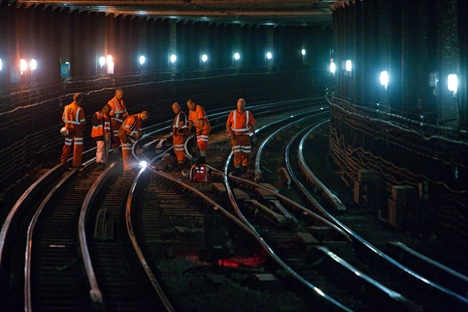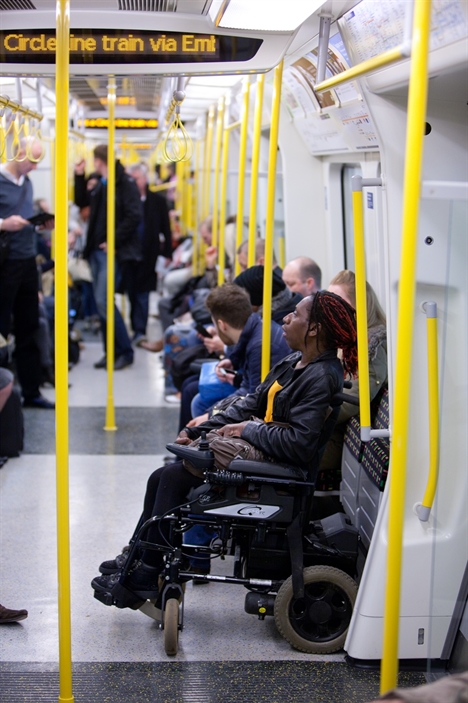30.04.15
Racing to keep pace with London’s growth
David Waboso, director of capital programmes at London Underground, looks back at recent achievements, and ahead to the next few years.
Last month brought together two big moments for London Underground (LU) – one celebrating the achievements of the recent past and the other confirming a huge project that will occupy us for the rest of the decade and beyond.
The ‘Building Our Capital’ report looked back at the development of LU since 2008; a time of progress and investment in the railway unmatched since the Victorian era. This has seen customer satisfaction, capacity and ridership all at record levels, with dramatic reductions in delays. As you might expect, capital investment and development has played no small part in these achievements.
At the start of this period, we were still tied to the complex Public Private Partnership (PPP) contract, which gradually failed through the 2000s. This was a huge risk to the future of the Tube, as planned modernisations were delayed and costs escalated. Getting out of the failed contract at the end of the decade was the first step to rebuilding our in-house engineering and project management expertise and delivering the improvements London continues to need to support its growth.
Since then, the introduction of more modern trains and infrastructure, along with innovative procurement, have lowered the cost of transporting each passenger by nearly a fifth, and greater exploitation of commercial assets has driven up non-fares revenue. We are now carrying the most customers in our history, with more than 1.27 billion journeys each year. Journeys are also quicker, with an average reduction of two minutes, and delays down by 43% over the period.
So what has changed to achieve this? Well, when you look back at it, a great deal.
Boosting capacity
We are racing to keep pace with the capital’s growth. The number of Londoners has grown by 600,000 since 2008 and is set to increase by a further 1.4 million to top 10 million by 2031. Our challenge is to match the demand for transport that this will create.
Recent years saw complete signalling upgrades of the Jubilee, Victoria and Northern lines, giving a major boost to the network’s capacity – up by one-third on the Jubilee line, 21% on the Victoria line and 20% on the Northern line (more on the Jubilee and Northern resignalling projects on page 180).
Thanks in no small part to these improvements, we are carrying more passengers than ever. Last November, we set a new record of 4.7 million journeys in one day, beating even the record set on the busiest day of the 2012 Games.
New trains
The Victoria Line also gained a brand new fleet of trains (the Bombardier-built 2009 stock), which by 2011 had completely replaced their outdated predecessors (the 1967 stock). We now run 34 trains an hour on the line, capable of carrying 10,000 extra passengers each hour at the busiest times. By next year this will increase to 36 per hour, making it the highest frequency service in the UK and comparable with the best in the world.
New S7 and S8 trains have also been introduced to the Metropolitan, Hammersmith & City and Circle lines, and are now coming to the District Line, with the full fleet in service by the end of 2016. These trains are the most advanced ever seen on the Tube, and the first with air-conditioning, walk-through carriages along their entire length and level access at many platforms due to their low-floor design. They have already hugely improved travel on the sub-surface rail (SSR) lines, but there’s much more to come. More on that later.
Better stations
Hand-in-hand with these projects, we have delivered station upgrades at major hubs including King’s Cross St Pancras, Green Park, Paddington, Blackfriars and Farringdon, including providing step-free access at many of these for the first time in their long histories. These, combined with wide automatic gates and boarding ramps, have made great strides in the accessibility of our network.
The station upgrades have also helped tackle congestion, with delays cut by 19%. At King’s Cross St Pancras, a third of customers now reach their trains through the new North ticket hall, hugely improving how people flow through the station.
Customer experience has also changed beyond recognition, with many innovations of recent years now a common part of daily travel. Service update boards introduced from 2009 onwards provide customers with minute-by-minute news about how their trains are running. Since 2012, wi-fi has been installed across the network, helping to bring real-time information and connectivity to customers on their mobile devices. Most recently, payment by contactless bank card has made paying for travel easier than ever, with hundreds of thousands of journeys made this way each day.
Coming down the track
One of our major aims over this period has been to reduce delays by 30%, a stiff target set by the Mayor of London. We are on track to meet this target, and have already reduced long delays (of over 15 minutes) by 43%. This was despite the pressure of carrying out major modernisation schemes on many lines at the same time.

But, with London’s population growing, we can’t be complacent, which is why our second announcement was for the modernisation of the next four Tube lines. Following the introduction of their award winning new trains, the Circle, District, Hammersmith & City and Metropolitan lines are now set for complete signalling upgrades and a modern train control system. To achieve this, we plan to use an improved version of the system built by Thales for the Jubilee and Northern lines.
This will let more trains run, faster and more frequently. More than double the number will run on the Circle Line alone. These four lines together make up nearly 40% of the network, and include the oldest part of the Tube, built in 1863. As well as circling central London, the lines reach out to suburbs to the west, north-west and east of the capital. Between them they carry around 1.3 million passengers a day – more than many European countries carry on their entire rail networks.
The total investment in these lines, including the new trains, is £5.54bn, supporting many thousands of jobs across London and the UK. As well as the trains and signalling, the upgrade includes new track, longer platforms and rebuilt train depots, with advanced technology to ensure the highest levels of train reliability.
Some of the current signalling system on the SSR lines belongs in a museum, having been operating since the early 20th century. While it remains safe to use, it is not capable of running trains close enough together to give Londoners the type of high-frequency service they need. We are now completing our negotiations with Thales to deliver the brand new system.
Once the upgrades are complete, most Circle Line customers will see a train up to every four minutes, instead of 10, and once we add in additional services on the other lines there will be trains every two minutes across much of the SSR network in central London.
This is a huge programme of work on the oldest and one of the most complex metro railways in the world. Work is expected to begin later this year, and customers will see the full benefits across all four lines by 2022. As we did successfully when upgrading the Northern Line, we will be aiming to minimise disruption to customers, only closing parts of lines when we absolutely have to. And ultimately, although there will be some disruption along the way, customers will see cuts to journey times, waiting times and crowding, alongside a much more reliable service.

Fit for the future
The SSR signalling upgrade is a new and very exciting project, but it’s far from all we have underway to modernise the Tube.
Major station upgrades to increase capacity and improve accessibility are in progress at Bond Street, Tottenham Court Road, Vauxhall and Victoria, with more planned at Bank, Camden Town, Holborn and others.
We are also introducing 24-hour ‘Night Tube’ services on core parts of the network from 12 September this year, radically improving night time travel options, cutting late-night journey times by up to an hour and boosting London’s economy by an estimated £360m.
At the same time we are radically improving how we serve customers in stations, closing under-used ticket office windows and bringing our station staff out into public areas where they can best assist people. By the end of this year there will be more LU staff on platforms than ever before and across the network there will be staff more visible and available to help customers buy the right ticket, plan journeys and feel safe and secure as they travel.
The last few years have been a time of great progress for the Tube and I am excited about the improvements planned for London over the rest of the decade and beyond. It’s a huge challenge and a great responsibility for all of us in the industry, but we will keep focused on our core promises to customers: better reliability, greater capacity, easier journeys and the best possible value for money.
FOR MORE INFORMATION
The Building Our Capital report is available at tfl.gov.uk
Also see: tfl.gov.uk/futuretube